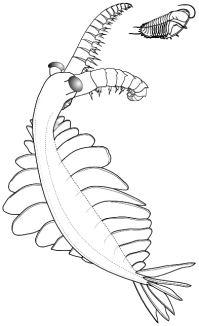
Trilobite tracks
(Cruziana)
courtesy of The Paleo Project
It is thought that the majority of trilobites were bottom-dwellers,
crawling on the sea floor, or within complex reefs,
acting as roving predators on smaller invertebrates
or as slow scavengers on organic debris.
|

A Bumastoid trilobite
crawling on the benthos. from the Virtual Silurian
Reef.
They were able to dig into the bottom sediments in search of food
and to conceal themselves from predators. Perhaps some were herbivores
on beds of algae (seaweed), or browsers on corals,
sponges, or bryozoans. Some may have been filter
feeders, orienting with the current and extracting plankton and organic
debris.
See related topic:
Trilobite Feeding
Habits
|

This image of oncocerid
nautiloids from the Virtual Silurian Reef
Nautiloids were probably important predators of trilobites.
Trilobites certainly were important prey for larger
creatures. At first these were large invertebrates, such as predatory worms,
nautiloids, sea scorpions (eurypterids), crustaceans, and perhaps Anomalocaridids. When fishes developed
and flourished in the Devonian,
we can be sure that trilobites were hard pressed by these new predators.
A hard exoskeleton and the ability to enroll protected trilobites from predators
and sudden unfavorable environmental changes.
|







 Opipeuter
Opipeuter 
